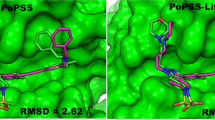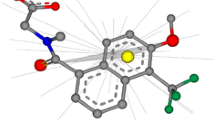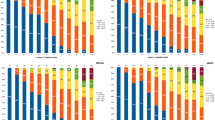Abstract
3-D ligand conformations are required for most ligand-based drug design methods, such as pharmacophore modeling, shape-based screening, and 3-D QSAR model building. Many studies of conformational search methods have focused on the reproduction of crystal structures (i.e. bioactive conformations); however, for ligand-based modeling the key question is how to generate a ligand alignment that produces the best results for a given query molecule. In this work, we study different conformation generation modes of ConfGen and the impact on virtual screening (Shape Screening and e-Pharmacophore) and QSAR predictions (atom-based and field-based). In addition, we develop a new search method, called common scaffold alignment, that automatically detects the maximum common scaffold between each screening molecule and the query to ensure identical coordinates of the common core, thereby minimizing the noise introduced by analogous parts of the molecules. In general, we find that virtual screening results are relatively insensitive to the conformational search protocol; hence, a conformational search method that generates fewer conformations could be considered “better” because it is more computationally efficient for screening. However, for 3-D QSAR modeling we find that more thorough conformational sampling tends to produce better QSAR predictions. In addition, significant improvements in QSAR predictions are obtained with the common scaffold alignment protocol developed in this work, which focuses conformational sampling on parts of the molecules that are not part of the common scaffold.












Similar content being viewed by others
Abbreviations
- QSAR:
-
Quantitative structure activity relationship
- LBDD:
-
Ligand-based drug design
- AQSAR:
-
Atom-based QSAR
- FQSAR:
-
Field-based QSAR
- NRB :
-
Average number of rotatable bonds
- NSR :
-
Average number of saturated rings
- MCMM/LMOD:
-
Monte Carlo molecular mechanics and low mode
- BEDROC:
-
Boltzmann-enhanced discrimination of the receiver operating characteristic
- EF:
-
Enrichment factor
- RMSD:
-
Root mean square deviation
- CSA:
-
Common scaffold alignment
- PLS:
-
Partial least-squares
- ACE:
-
Angiotensin-converting enzyme
- AChE:
-
Acetylcholinesterase
- ADA:
-
Adenosine deaminase
- ALR2:
-
Aldose reductase
- AmpC:
-
AmpC β-lactamase
- AR:
-
Androgen receptor
- CDK2:
-
Cyclin-dependent kinase 2
- COMT:
-
Catechol O-methyltransferase
- COX1:
-
Cyclooxygenase-1
- COX2:
-
Cyclooxygenase-2
- DHFR:
-
Dihydrofolate reductase
- EGFr:
-
Epidermal growth factor receptor
- ER:
-
Estrogen receptor
- FGFr1:
-
Fibroblast growth factor receptor kinase
- fXa:
-
Factor Xa
- GART:
-
Glycinamide ribonucleotide transformylase
- GPB:
-
Glycogen phosphorylase β
- GR:
-
Glucocorticoid receptor
- HIVpr:
-
HIV protease
- HIVrt:
-
HIV reverse transcriptase
- HMGR:
-
Hydroxymethylglutaryl-CoA reductase
- HSP90:
-
Human heat shock protein 90
- InhA:
-
Enoyl ACP reductase
- MR:
-
Mineralocorticoid receptor
- NA:
-
Neuraminidase
- P38:
-
P38 mitogen activated protein
- PARP:
-
Poly(ADP-ribose) polymerase
- PDE5:
-
Phosphodiesterase 5
- PDGFrb:
-
Platelet derived growth factor receptor kinase
- PNP:
-
Purine nucleoside phosphorylase
- PPAR:
-
Peroxisome proliferator activated receptor γ
- PR:
-
Progesterone receptor
- RXR:
-
Retinoic X receptor R
- SAHH:
-
S-adenosyl-homocysteine hydrolase
- Src:
-
Tyrosine kinase SRC
- TK:
-
Thymidine kinase
- VEGFr2:
-
Vascular endothelial growth factor receptor
- PTP1B:
-
Protein tyrosine phosphatase 1B
- LCK:
-
Lymphocyte-specific tyrosine kinase
- JNK:
-
c-Jun N-terminal kinase
- ERK2:
-
Extracellular signal-regulated kinase 2
- CHK1:
-
Checkpoint kinase 1
- EPHX2:
-
Cytoplasmic epoxide hydrolase 2
- UPA:
-
Urokinase-type plasminogin activator
- DPP4:
-
Dipeptidyl peptidase IV
References
Koeppen H, Kriegl J, Lessel U, Tautermann CS, Wellenzohn B (2011) Ligand-based virtual screening. In: Sotriffer C (ed) Virtual screening: principles, challenges, and practical guidelines. Wiley-VCH Verlag GmbH & Co. KGaA, Weinheim, pp 61–85
Hert J, Willett P, Wilton DJ, Acklin P, Azzaoui K, Jacoby E, Schuffenhauer A (2006) New methods for ligand-based virtual screening: use of data fusion and machine learning to enhance the effectiveness of similarity searching. J Chem Inf Model 46:462–470
Geppert H, Vogt M, Bajorath J (2010) Current trends in ligand-based virtual screening: molecular representations, data mining methods, new application areas, and performance evaluation. J Chem Inf Model 50:205–216
Stahura FL, Bajorath J (2005) New methodologies for ligand-based virtual screening. Curr Pharm Des 11:1189–1202
Sun H (2008) Pharmacophore-based virtual screening. Curr Med Chem 15:1018–1024
Hawkins PC, Skillman AG, Nicholls A (2007) Comparison of shape-matching and docking as virtual screening tools. J Med Chem 50:74–82
McGaughey GB, Sheridan RP, Bayly CI, Culberson JC, Kreatsoulas C, Lindsley S, Maiorov V, Truchon JF, Cornell WD (2007) Comparison of topological, shape, and docking methods in virtual screening. J Chem Inf Model 47:1504–1519
Kubinyi H (1997) QSAR and 3D QSAR in drug design Part 1: methodology. Drug Discov Today 2:457–467
Sastry GM, Inakollu VSS, Sherman W (2013) Boosting virtual screening enrichments with data fusion: coalescing hits from two-dimensional fingerprints, shape, and docking. J Chem Inf Model 53:1531–1542
Kirchmair J, Ristic S, Eder K, Markt P, Wolber G, Laggner C, Langer T (2007) Fast and efficient in silico 3D screening: toward maximum computational efficiency of pharmacophore-based and shape-based approaches. J Chem Inf Model 47:2182–2196
Kirchmair J, Distinto S, Markt P, Schuster D, Spitzer GM, Liedl KR, Wolber G (2009) How to optimize shape-based virtual screening: choosing the right query and including chemical information. J Chem Inf Model 49:678–692
Singh J, Chuaqui CE, Boriack-Sjodin P, Lee WC, Pontz T, Corbley MJ, Cheung HK, Arduini RM, Mead JN, Newman MN (2003) Successful shape-based virtual screening: the discovery of a potent inhibitor of the type I TGFβ receptor kinase (TβRI). Bioorg Med Chem Lett 13:4355–4359
Mason JS, Morize I, Menard PR, Cheney DL, Hulme C, Labaudiniere RF (1999) New 4-point pharmacophore method for molecular similarity and diversity applications: overview of the method and applications, including a novel approach to the design of combinatorial libraries containing privileged substructures. J Med Chem 42:3251–3264
Martin YC, Bures MG, Danaher EA, DeLazzer J, Lico I, Pavlik PA (1993) A fast new approach to pharmacophore mapping and its application to dopaminergic and benzodiazepine agonists. J Comput Aided Mol Des 7:83–102
Ekins S, Bravi G, Binkley S, Gillespie JS, Ring BJ, Wikel JH, Wrighton SA (1999) Three and four dimensional-quantitative structure activity relationship (3D/4D-QSAR) analyses of CYP2D6 inhibitors. Pharmacogenet Genomics 9:477–489
Foloppe N, Chen IJ (2009) Conformational sampling and energetics of drug-like molecules. Curr Med Chem 16:3381–3413
Mohamadi F, Richards NGJ, Guida WC, Liskamp R, Lipton M, Caufield C, Chang G, Hendrickson T, Still WC (1990) MacroModel—an integrated software system for modeling organic and bioorganic molecules using molecular mechanics. J Comput Chem 11:440–467
Chang G, Guida WC, Still WC (1989) An internal coordinate Monte Carlo method for searching conformational space. J Am Chem Soc 111:4379–4386
Ferguson DM, Raber DJ (1989) A new approach to probing conformational space with molecular mechanics: random incremental pulse search. J Am Chem Soc 111:4371–4378
Crippen G (1978) Note rapid calculation of coordinates from distance matrices. J Comput Phys 26:449–452
Izrailev S, Zhu F, Agrafiotis DK (2006) A distance geometry heuristic for expanding the range of geometries sampled during conformational search. J Comput Chem 27:1962–1969
Rusinko A III, Sheridan RP, Nilakantan R, Haraki KS, Bauman N, Venkataraghavan R (1989) Using CONCORD to construct a large database of three-dimensional coordinates from connection tables. J Chem Inf Comput Sci 29:251–255
Gasteiger J, Rudolph C, Sadowski J (1990) Automatic generation of 3D-atomic coordinates for organic molecules. Tetrahedron Comput Methodol 3:537–547
Hawkins PC, Skillman AG, Warren GL, Ellingson BA, Stahl MT (2010) Conformer generation with OMEGA: algorithm and validation using high quality structures from the Protein Databank and Cambridge Structural Database. J Chem Inf Model 50:572–584
Kolossváry I, Guida WC (1996) Low mode search. An efficient, automated computational method for conformational analysis: application to cyclic and acyclic alkanes and cyclic peptides. J Am Chem Soc 118:5011–5019
Labute P (2010) LowModeMD-implicit low-mode velocity filtering applied to conformational search of macrocycles and protein loops. J Chem Inf Model 50:792–800
Watts KS, Dalal P, Murphy RB, Sherman W, Friesner RA, Shelley JC (2010) ConfGen: a conformational search method for efficient generation of bioactive conformers. J Chem Inf Model 50:534–546
Anghelescu AV, DeLisle RK, Lowrie JF, Klon AE, Xie X, Diller DJ (2008) Technique for generating three-dimensional alignments of multiple ligands from one-dimensional alignments. J Chem Inf Model 48:1041–1054
Jones G, Gao Y, Sage CR (2009) Elucidating molecular overlays from pairwise alignments using a genetic algorithm. J Chem Inf Model 49:1847–1855
Korb O, Monecke P, Hessler G, Stutzle T, Exner TE (2010) pharmACOphore: multiple flexible ligand alignment based on ant colony optimization. J Chem Inf Model 50:1669–1681
Lemmen C, Lengauer T, Klebe G (1998) FLEXS: a method for fast flexible ligand superposition. J Med Chem 41:4502–4520
Marialke J, Korner R, Tietze S, Apostolakis J (2007) Graph-based molecular alignment (GMA). J Chem Inf Model 47:591–601
Robinson DD, Lyne PD, Richards WG (1999) Alignment of 3D-structures by the method of 2D-projections. J Chem Inf Comput Sci 39:594–600
Klabunde T, Giegerich C, Evers A (2012) MARS: computing three-dimensional alignments for multiple ligands using pairwise similarities. J Chem Inf Model 52:2022–2030
Giangreco I, Cosgrove DA, Packer MJ (2013) An extensive and diverse set of molecular overlays for the validation of pharmacophore programs. J Chem Inf Model 53:852–866
Sastry M, Dixon S, Sherman W (2011) Rapid shape-based ligand alignment and virtual screening method based on atom/feature-pair similarities and volume overlap scoring. J Chem Inf Model 51:2455–2466
Salam NK, Nuti R, Sherman W (2009) Novel method for generating structure-based pharmacophores using energetic analysis. J Chem Inf Model 49:2356–2368
Hopfinger AJ, Wang S, Tokarski JS, Jin B, Albuquerque M, Madhav PJ, Duraiswami C (1997) Construction of 3D-QSAR models using the 4D-QSAR analysis formalism. J Am Chem Soc 119:10509–10524
Huang N, Shoichet BK, Irwin JJ (2006) Benchmarking sets for molecular docking. J Med Chem 49:6789–6801
Ligprep. 2.5. New York, NY: Schrodinger LLC; 2013
Jorgensen WL, Tirado-Rives J (1988) The OPLS potential function for proteins. Energy minimizations for crystals of cyclic peptides and crambin. J Am Chem Soc 110:1657–1666
Kaminski GA, Friesner RA, Tirado-Rives J, Jorgensen WL (2001) Evaluation and reparameterization of the OPLS-AA force field for proteins via comparison with accurate quantum chemical calculations on peptides. J Phys Chem B 105:6474–6487
Epik. 2.3. New York, NY: Schrödinger LLC; 2013
Schaal W, Karlsson A, Ahlsen G, Lindberg J, Andersson HO, Danielson UH, Classon B, Unge T, Samuelsson B, Hulten J, Hallberg A, Karlen A (2001) Synthesis and comparative molecular field analysis (Comfa) of symmetric and nonsymmetric cyclic sulfamide HIV-1 protease inhibitors. J Med Chem 44:155–169
Matter H, Defossa E, Heinelt U, Blohm PM, Schneider D, Muller A, Herok S, Schreuder H, Liesum A, Brachvogel V, Lonze P, Walser A, Al-Obeidi F, Wildgoose P (2002) Design and quantitative structure-activity relationship of 3-amidinobenzyl-1H-indole-2-carboxamides as potent, nonchiral, and selective inhibitors of blood coagulation factor Xa. J Med Chem 45:2749–2769
Hardcastle IR, Arris CE, Bentley J, Boyle FT, Chen Y, Curtin NJ, Endicott JA, Gibson AE, Golding BT, Griffin RJ, Jewsbury P, Menyerol J, Mesguiche V, Newell DR, Noble ME, Pratt DJ, Wang LZ, Whitfield HJ (2004) N2-substituted O6-cyclohexylmethylguanine derivatives: potent inhibitors of cyclin-dependent kinases 1 and 2. J Med Chem 47:3710–3722
Wan ZK, Lee J, Xu W, Erbe DV, Joseph-McCarthy D, Follows BC, Zhang YL (2006) Monocyclic thiophenes as protein tyrosine phosphatase 1B inhibitors: capturing interactions with Asp48. Bioorg Med Chem Lett 16:4941–4945
DiMauro EF, Newcomb J, Nunes JJ, Bemis JE, Boucher C, Buchanan JL, Buckner WH, Cee VJ, Chai L, Deak HL, Epstein LF, Faust T, Gallant P, Geuns-Meyer SD, Gore A, Gu Y, Henkle B, Hodous BL, Hsieh F, Huang X, Kim JL, Lee JH, Martin MW, Masse CE, McGowan DC, Metz D, Mohn D, Morgenstern KA, Oliveira-dos-Santos A, Patel VF, Powers D, Rose PE, Schneider S, Tomlinson SA, Tudor YY, Turci SM, Welcher AA, White RD, Zhao H, Zhu L, Zhu X (2006) Discovery of aminoquinazolines as potent, orally bioavailable inhibitors of Lck: synthesis, SAR, and in vivo anti-inflammatory activity. J Med Chem 49:5671–5686
Liu M, Wang S, Clampit JE, Gum RJ, Haasch DL, Rondinone CM, Trevillyan JM, Abad-Zapatero C, Fry EH, Sham HL, Liu G (2007) Discovery of a new class of 4-anilinopyrimidines as potent c-Jun N-terminal kinase inhibitors: synthesis and SAR studies. Bioorg Med Chem Lett 17:668–672
Aronov AM, Baker C, Bemis GW, Cao J, Chen G, Ford PJ, Germann UA, Green J, Hale MR, Jacobs M, Janetka JW, Maltais F, Martinez-Botella G, Namchuk MN, Straub J, Tang Q, Xie X (2007) Flipped out: structure-guided design of selective pyrazolylpyrrole ERK inhibitors. J Med Chem 50:1280–1287
Tong Y, Claiborne A, Stewart KD, Park C, Kovar P, Chen Z, Credo RB, Gu WZ, Gwaltney SL 2nd, Judge RA, Zhang H, Rosenberg SH, Sham HL, Sowin TJ, Lin NH (2007) Discovery of 1,4-dihydroindeno[1,2-c]pyrazoles as a novel class of potent and selective checkpoint kinase 1 inhibitors. Bioorg Med Chem 15:2759–2767
Eldrup AB, Soleymanzadeh F, Farrow NA, Kukulka A, De Lombaert S (2010) Optimization of piperidyl-ureas as inhibitors of soluble epoxide hydrolase. Bioorg Med Chem Lett 20:571–575
Katz BA, Elrod K, Verner E, Mackman RL, Luong C, Shrader WD, Sendzik M, Spencer JR, Sprengeler PA, Kolesnikov A, Tai VW, Hui HC, Breitenbucher JG, Allen D, Janc JW (2003) Elaborate manifold of short hydrogen bond arrays mediating binding of active site-directed serine protease inhibitors. J Mol Biol 329:93–120
Peters JU, Weber S, Kritter S, Weiss P, Wallier A, Boehringer M, Hennig M, Kuhn B, Loeffler BM (2004) Aminomethylpyrimidines as novel DPP-IV inhibitors: a 10(5)-fold activity increase by optimization of aromatic substituents. Bioorg Med Chem Lett 14:1491–1493
Mertens A, Zilch H, Konig B, Schafer W, Poll T, Kampe W, Seidel H, Leser U, Leinert H (1993) Selective non-nucleoside HIV-1 reverse transcriptase inhibitors. New 2,3-dihydrothiazolo[2,3-a]isoindol-5(9bH)-ones and related compounds with anti-HIV-1 activity. J Med Chem 36:2526–2535
Confgen. 2.3. New York, NY: Schrödinger LLC; 2013
Chen IJ, Foloppe N (2010) Drug-like bioactive structures and conformational coverage with the LigPrep/ConfGen suite: comparison to programs MOE and Catalyst. J Chem Inf Model 50:822–839
Phase. 3.5. New York, NY: Schrödinger LLC; 2013
Dixon SL, Smondyrev AM, Knoll EH, Rao SN, Shaw DE, Friesner RA (2006) PHASE: a new engine for pharmacophore perception, 3D QSAR model development, and 3D database screening: 1. Methodology and preliminary results. J Comput Aided Mol Des 20:647–671
Dixon SL, Smondyrev AM, Rao SN (2006) PHASE: a novel approach to pharmacophore modeling and 3D database searching. Chem Biol Drug Des 67:370–372
MacroModel. 9.9. New York, NY: Schrödinger LLC; 2013
Sastry GM, Adzhigirey M, Day T, Annabhimoju R, Sherman W (2013) Protein and ligand preparation: parameters, protocols, and influence on virtual screening enrichments. J Comput Aided Mol Des 27:221–234
Impact. 5.8. New York, NY: Schrödinger LLC; 2013
Shivakumar D, Williams J, Wu Y, Damm W, Shelley J, Sherman W (2010) Prediction of absolute solvation free energies using molecular dynamics free energy perturbation and the OPLS force field. J Chem Theory Comput 6:1509–1519
Glide. 5.8. New York, NY: Schrödinger LLC; 2013
Truchon J-F, Bayly CI (2007) Evaluating virtual screening methods: good and bad metrics for the “early recognition” problem. J Chem Inf Model 47:488–508
Cramer RD III, Patterson DE, Bunce JD (1988) Comparative molecular field analysis (CoMFA). 1. Effect of shape on binding of steroids to carrier proteins. J Am Chem Soc 110:5959–5967
Klebe G, Abraham U, Mietzner T (1994) Molecular similarity indices in a comparative analysis (CoMSIA) of drug molecules to correlate and predict their biological activity. J Med Chem 37:4130–4146
Ghose AK, Viswanadhan VN, Wendoloski JJ (1998) Prediction of hydrophobic (Lipophilic) properties of small organic molecules using fragmental methods: an analysis of ALOGP and CLOGP methods. J Phys Chem A 102:3762–3772
Golbraikh A, Tropsha A (2001) Beware of q2! J Mol Graph Model 20:269–276
Abel R, Salam NK, Shelley J, Farid R, Friesner RA, Sherman W (2011) Contribution of explicit solvent effects to the binding affinity of small-molecule inhibitors in blood coagulation factor serine proteases. Chem Med Chem 6:1049–1066
Author information
Authors and Affiliations
Corresponding author
Additional information
Daniel Cappel and Jianxin Duan have contributed equally to this work.
Electronic supplementary material
Below is the link to the electronic supplementary material.
Rights and permissions
About this article
Cite this article
Cappel, D., Dixon, S.L., Sherman, W. et al. Exploring conformational search protocols for ligand-based virtual screening and 3-D QSAR modeling. J Comput Aided Mol Des 29, 165–182 (2015). https://doi.org/10.1007/s10822-014-9813-4
Received:
Accepted:
Published:
Issue Date:
DOI: https://doi.org/10.1007/s10822-014-9813-4




